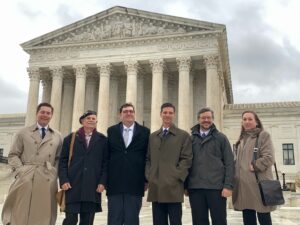Frequently asked questions about Wilkins v. United States

What are the facts of this case?
At issue in Wilkins v. United States is a forest road, a disagreement over easement terms, and a question about the statute of limitations on quiet title claims.
Wil Wilkins and Jane Stanton are two neighbors living near a Montana national forest who just want peace and privacy. Wil and Jane recognize that the U.S. Forest Service and specific permit holders (like loggers and ranchers) have the right to cross their property to get to the forest, and they were happy with that limited activity. But after the Forest Service opened the road to the public—violating the decades-old easement agreement—Wil and Jane’s refuge in Bitterroot National Forest was disturbed by hunting, traffic hazards, noise, theft, and trespassing. Wil’s cat was even shot, but fortunately, the cat survived.
Wil, 72, is a blacksmith whose work has been featured in interior design magazines. He is also a veteran who has been diagnosed with post-traumatic stress disorder (PTSD). Jane is a widow who lost her husband in 2013. Both Wil and Jane value their private space. The county where they live, Ravalli County, has an average of only 18 people for every square mile.
The U.S. Forest Service should not be allowed to pull a bait-and-switch that severely hampers Wil and Jane’s ability to enjoy their private property.
Is there a statute of limitations?
The legal question the Supreme Court has decided to take up is: Does the Quiet Title Act’s statute of limitations prevent Wil and Jane’s lawsuit from being considered, or is it a claim-processing rule to which there can be exceptions?
Wil and Jane filed a quiet title claim against the federal government in 2018. The Quiet Title Act (QTA) allows property owners to sue the United States over a disputed title to property in which the federal government has claimed an interest.
However, the Act requires such lawsuits to be filed no more than 12 years after the property owner “knew or should have known of the claim of the United States.”
The Ninth Circuit dismissed Wil and Jane’s lawsuit last year, holding that the statute of limitations is “jurisdictional,” which means a court cannot consider the merits of the case if the time limit appears to have expired. Wil and Jane’s case was dismissed without them being able to show how the Forest Service changed the terms of the easement. In fact, the case was dismissed without Wil and Jane being able to fully argue that they brought the case within the 12-year time limit. They maintain that their lawsuit was brought within the time limit.
Pacific Legal Foundation disagrees with the Ninth Circuit: We argue the Quiet Title Act’s statute of limitations is merely a “claim-processing rule.” A claim-processing rule is meant to ensure timely filing of litigation and is, according to the Supreme Court, “important and mandatory” but not jurisdictional—meaning, it should not automatically preclude a court from considering a case on its merits. Claim-processing rules also allow courts to allow an untimely filed case to proceed if it is in the interest of justice
If there is a dispute about when the time limit started to run, the court would have the power—the jurisdiction—to hold a hearing to consider disputed evidence. The government would bear the burden to show the time limit has passed, and the government can choose to waive a claim-processing defense.
Will this case affect statutes of limitations outside of the Quiet Title Act?
It may. Over the past few decades, the Supreme Court has repeatedly held that most statutes of limitations are not jurisdictional. If the Court decides in favor of Wil and Jane, it will continue the trend and signal that lower courts should not treat statutes of limitations as jurisdictional.
When will the case be argued at the Supreme Court, and when will its decision be issued?
The Court will hear oral argument in Wilkins v. United States on November 30, 2022, with a decision to come sometime before June 2023.
How does this case relate to Boechler v. Commissioner and Arellano v. McDonough?
Boechler was decided last term, and Arellano was heard this term—both deal with whether time limits are jurisdictional. In Boechler, the Court unanimously held that a time limit for requesting a Tax Court hearing is not jurisdictional. Arellano similarly addressed time limits for requesting veterans’ disability benefits.
Where is the property located, and what is its current status?
Wil and Jane’s properties are in Ravalli County, Montana, about an hour and a half south of Missoula. The county is part of a north-south mountain valley bordered by the Sapphire Mountains on the East and the Bitterroot Mountains on the West. The area is often referred to as the Bitterroot Valley, which is named for the Bitterroot flower.
If the Supreme Court should decide in favor of Wil Wilkins and Jane Stanton, what happens then?
The case will go back to the district court, where Wil and Jane will have their day in court. If the government chooses to argue that Wil and Jane did not file within the statute of limitations, it would have to prove it to the court after an evidentiary hearing.
What would a loss at the Supreme Court mean?
A loss would mean that there will still be a disagreement about how the Forest Service can use the road and the agency’s obligations to the private property owners, but Wil and Jane will have no way to protect their property rights. Their only hope is that the government eventually decides to sue them over the road.
Why should Americans care about this case?
Congress passed the Quiet Title Act (QTA) to give individuals the ability to vindicate their rights in courts. Especially in the West, where the government owns over half of the land, disputes about who owns what land can linger for years. There are also many easements that have been granted for limited purposes—like railroad easements—that the federal government may claim it owns years after the railroad abandons its easement. When courts impose strict rules that prevent these cases from being resolved, it upsets Congress’ intent in passing the QTA.




